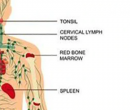Symptoms of SAD
If you're afflicted with SAD you might start to notice symptoms starting up in the fall and ending as spring comes around. As a subtype of depression, you might feel any of the following: losing interest in activities you used to enjoy, trouble sleeping, trouble concentrating, frequent thoughts of death or suicide. You might also feel symptoms specific to winter-onset SAD like: low energy, irritability, problems getting along with others, hypersensitivity to rejection, heavy feeling in arms or legs, oversleeping, appetite changes (esp. craving carbohydrates), and weight gain.
Treatments Old and New
Light therapy has been an often-prescribed treatment for those who suffer from SAD. It involves sitting under a very bright, often blue-tinged light for 30-60 minutes every day, usually early in the morning. This isn't just any old light bulb, or a sun lamp someone would use for tanning, but instead a bulb or set of bulbs designed for light therapy that mimics outdoor light.
Another treatment is CBT or cognitive behavioral therapy, which has often been used to treat depression, but a recent study shows it has shown promise in treating SAD as well. Also known as psychotherapy, treatment can help Identify and change negative thoughts and behaviors that may be making you feel worse and help you manage stress and your SAD in healthy ways.
Some medical professionals prescribe antidepressant medications for SAD sufferers, but it's not a universal treatment that fits everyone's needs. Benefits can take weeks to appear, and you'll need to talk to your doctor in order to get a prescription that's right for you.
Exercise is also a great way to boost your mood and help fight depression. Even though it's cold outside, as little as 15 minutes of activity a day can make you feel better, bit by bit. You may want to burrow into that pile of blankets, but try just a bit of movement every day — maybe 15 minutes of walking with a friend or your favorite pooch, or strolling around indoors at the mall or even on the treadmill at that gym you pay for anyway. Try someindoor workouts, or take some time to bundle up if you're heading outside.
Eating right is also important for those who are suffering with SAD or other forms of depression. Boost serotonin with foods that don't leave you feeling worse (think sugar and caffeine which can leave you in crash mode). Think about talking to a registered dietitian about a plan that can help you fight off SAD but is right for any weight goals or health issues you might also have. Try to stash healthy snacks at work so you're not tempted by that mid-afternoon slump.
Supplements like St. John's wort, melatonin, vitamin D, and omega-3 fatty acids are sometimes used, but aren't regulated by the FDA and have varying research showingvaried effectiveness. Alternative therapies like yoga, acupuncture, and meditation can also help, and be simple to incorporate into your busy day, even at work.
Most importantly, it's helpful to have a support network around you when you're feeling depressed. Family and friends, plus your medical care team, can help keep you strong during moments when depression can take hold. Learn how to recognize signs of depression, so you can be a help to friends and co-workers.





